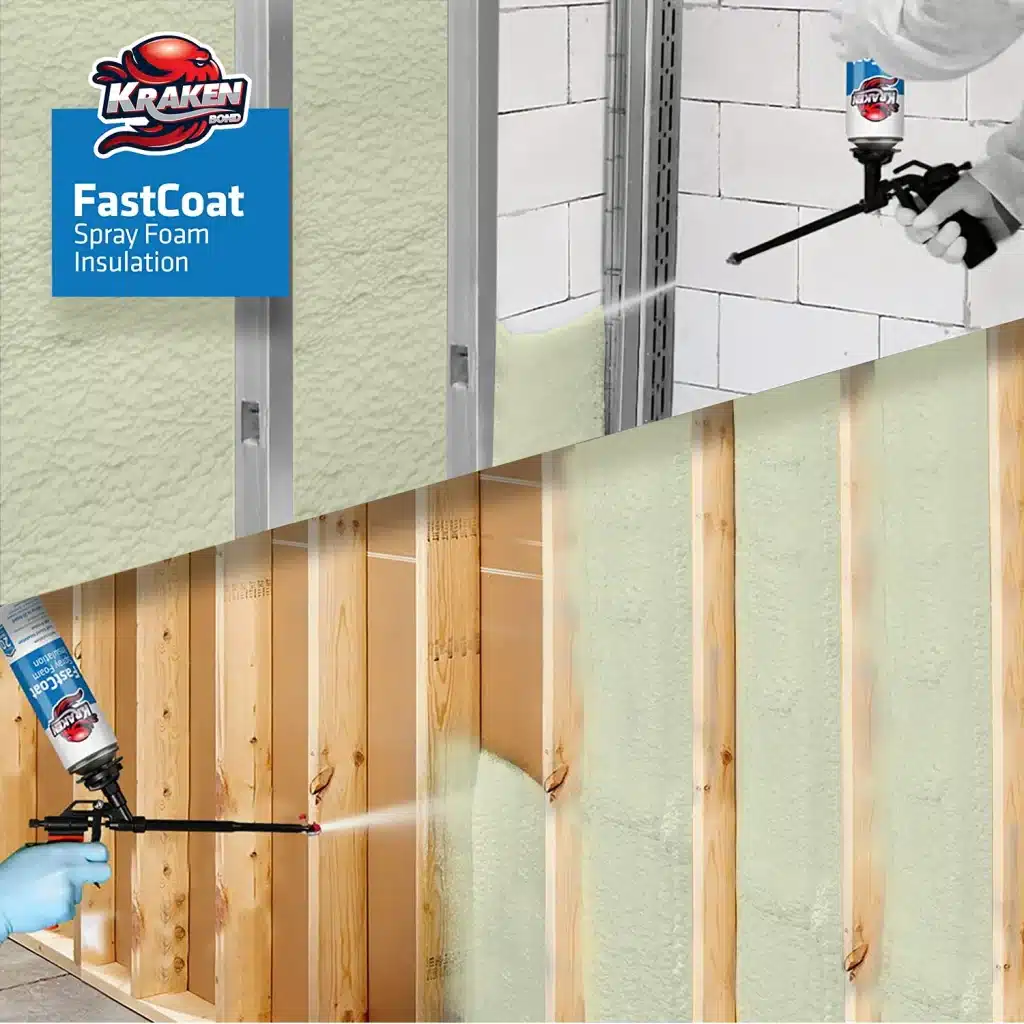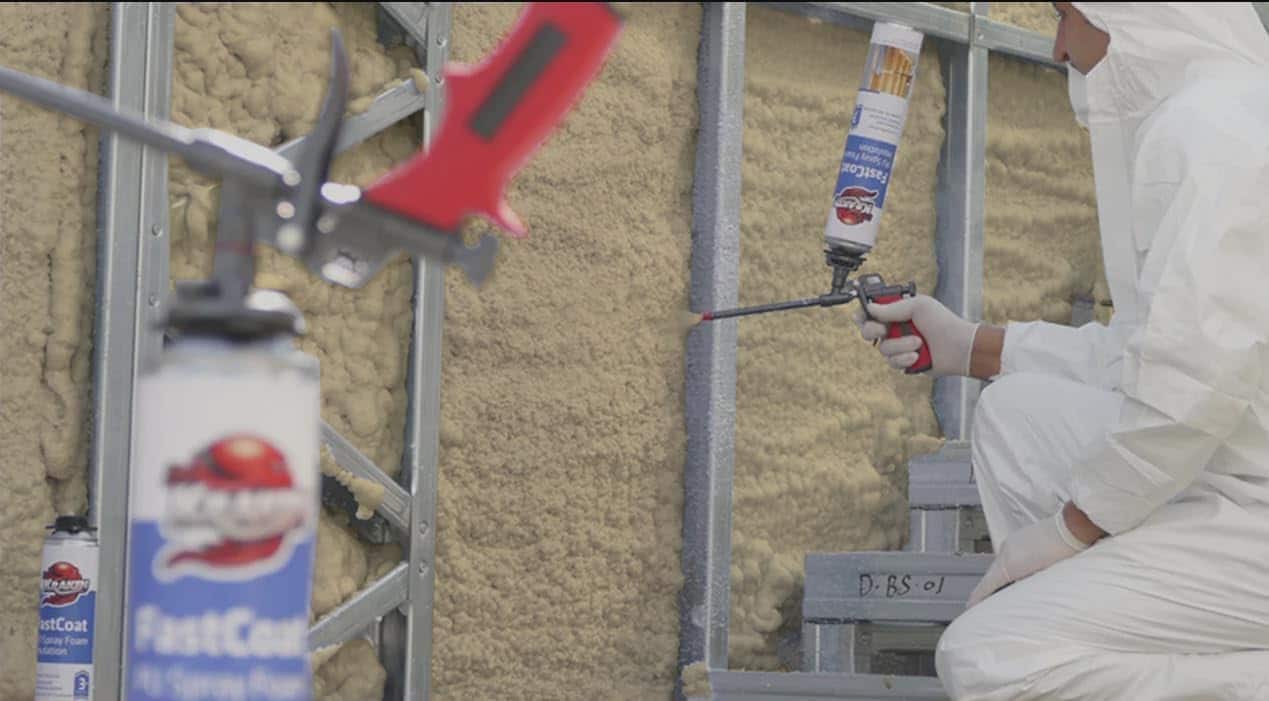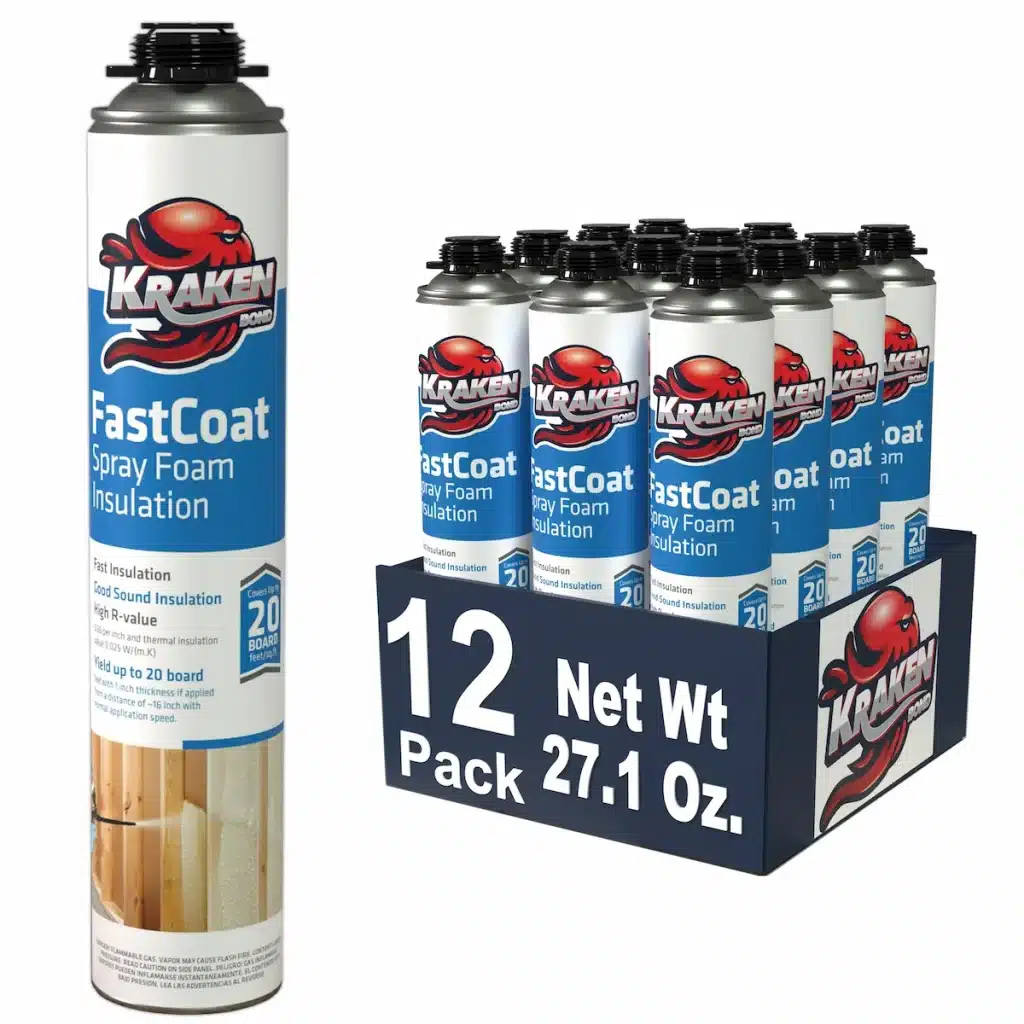Spray foam insulation is a convenient and effective way to seal small gaps and cracks around your home. It provides a long-lasting insulator and sealer that helps improve energy efficiency.
Historically, this canned spray insulation was only useful for areas like window and door frames, where it helps stop air infiltration. But recent advances in closed-cell technologies, from brands like Tiger Foram and Kraken Bond, have created an effective method for DIYers to increase r-value.
There are different types of spray foam available, such as closed-cell and open-cell. Closed-cell spray foam offers better energy efficiency by creating an airtight seal, while open-cell is less dense but still effective. Some products, like eco spray foam, are made with plant-based materials, making them a more environmentally friendly choice.
When applying spray foam insulation, cleanliness and thoroughness are key. Ensuring surfaces are clean and applying the foam in a continuous bead without breaks will achieve the best seal. Water-resistant versions can be used in areas exposed to rain, though they are not fully waterproof.
Key Points
- Spray foam insulation in a can is great for sealing small gaps and improving energy efficiency.
- Different types of spray foam offer varied benefits like airtight seals and eco-friendly options.
- Proper application involves clean surfaces and continuous beads for an effective seal.
Understanding Spray Foam Insulation Benefits
Spray foam insulation is a versatile material used to insulate and seal buildings. It has different types and offers various benefits for energy efficiency, moisture resistance, and structural integrity.
Composition and Types
Spray foam insulation is created from two main components: isocyanate and polyol resin. These chemicals react when mixed, causing the foam to expand. There are two primary types of spray foam insulation: open-cell and closed-cell.
- Open-cell foam is less dense and more flexible. It provides a good air barrier but has a lower R-value.
- Closed-cell foam is denser and forms a more rigid structure. It offers a higher R-value, excellent moisture resistance, and increased structural support.
Both types have specific uses depending on the needs of the building and the climate conditions.
Mechanism of Action
When applied, spray foam insulation starts as a liquid. As it is sprayed, it expands up to 30-60 times its original volume. This expansion allows it to fill gaps, cracks, and crevices thoroughly.
- The foam forms a tight seal, preventing air leakage.
- It adheres strongly to surfaces, which helps in reducing thermal bridges.
- Once cured, the foam hardens into a durable layer that provides continuous insulation.
This effective sealing capability not only improves thermal performance but also contributes to a healthier indoor environment by reducing allergens and pollutants.
Benefits and Uses
The benefits of spray foam insulation are numerous. It enhances energy efficiency by significantly reducing heating and cooling costs. Closing gaps and voids reduces the load on HVAC systems, helping to maintain a consistent indoor temperature.
- Moisture resistance: Closed-cell foam acts as a vapor barrier, protecting structures from moisture damage.
- Noise reduction: Both types of foam provide soundproofing, leading to quieter interiors.
- Structural support: Closed-cell foam can strengthen walls and roofs.
Spray foam insulation is used in various applications, from residential homes to commercial buildings. It can be applied to roofs, walls, and floors, making it a versatile option for energy-efficient construction.
What Is A Good Brand Of Spray Foam in A Can?
Kraken Bond Fastcoat Insulation Spray Foam
(Closed Cell Expanding Foam In A Can)
Kraken FastCoat is a notable brand for spray foam insulation in a can. This product stands out due to its outstanding adhesion to most building materials.
One of the primary features of Kraken FastCoat is its excellent R-Value of 5.66 per inch. This high thermal insulation value ensures effective energy efficiency.
Kraken FastCoat is easy to apply even on uneven and hard-to-reach surfaces. This makes it suitable for various structural components like attics, crawl spaces, and interior walls.
Below are some notable features:
| Feature | Details |
|---|---|
| R-Value | 5.66 per inch |
| Thermal Conductivity | 0.025 W/(m.K) |
| Coverage | Up to 20 board feet at 1-inch thickness |
| Temperature Resistance | -103°F to 239°F |
| Effective Lifespan | 25 years |
The dense structure of the foam helps in preventing water, air, and bug infiltration. This characteristic is crucial for maintaining a controlled indoor environment.
Additionally, Kraken FastCoat is paintable after curing, providing flexibility for aesthetic finishes. The foam can be applied using a spray foam gun, which ensures precise application.
Overall, Kraken FastCoat offers a comprehensive insulation solution for both residential and commercial applications, making it a reliable choice for those in need of effective spray foam insulation.
How To Apply Spray Foam
Applying spray foam insulation requires careful preparation, adherence to safety protocols, and mastering effective spraying techniques. Each of these steps is crucial to ensure a successful and efficient insulation process.
Preparation Steps
Before starting the application of spray foam insulation, gather all necessary materials and tools. This includes the spray foam can, protective gear, and a spray gun if needed. Inspect the area to be insulated, ensuring it is clean and free from dust or debris.
Measure the area to determine the amount of insulation required. For best results, follow the manufacturer’s instructions on the can regarding temperature and humidity conditions. Ensure there are no leaks or gaps that can lead to uneven application or wasted material. By prepping the area properly, the application process will be smoother and more efficient.
Safety Measures
Safety is paramount when using spray foam insulation. Wearing appropriate protective gear, such as gloves, goggles, and a mask, is necessary to prevent skin and eye irritation, as well as inhalation of harmful fumes. Ventilate the area well to avoid buildup of toxic vapors.
Keep a fire extinguisher nearby as spray foam can be flammable. Avoid applying foam near open flames or hot surfaces. Ensure that the working environment is well-ventilated to minimize exposure to chemicals. Always follow safety instructions provided by the manufacturer to prevent accidents and health risks.
Spraying Techniques
Mastering spraying techniques is essential for an even and effective application. Hold the spray gun or can at a consistent distance of about 6-12 inches from the surface. Apply the foam in layers, starting with a thin coat and allowing it to expand before adding more.
Use a steady hand motion to avoid creating gaps or bubbles in the foam. Overfilling can lead to overspill, so it’s better to apply in controlled amounts. Pay attention to hard-to-reach areas to ensure complete coverage. By refining these techniques, the insulation will be more uniform and effective in providing thermal resistance.
Performance Metrics
Spray foam insulation in a can is measured by several key performance metrics, including its thermal resistance (R-Value), effectiveness as an air and moisture barrier, and its longevity and durability.
Thermal Resistance (R-Value)
Thermal resistance, or R-Value, measures how well spray foam insulation resists heat flow. Higher R-Values indicate better insulating performance. Closed-cell spray foam typically has an R-Value of R-6.0 to R-7.0 per inch, making it highly effective for thermal insulation. Open-cell spray foam usually has an R-Value of R-3.5 to R-3.6 per inch. This means closed-cell foam provides double the insulating power compared to open-cell foam of the same thickness. These properties make spray foam an efficient choice for maintaining indoor temperature.
Air and Moisture Barriers
One of the most critical features of spray foam insulation is its ability to act as an air and moisture barrier. Closed-cell spray foam is particularly effective due to its denser structure, which prevents air leakage and water infiltration. This helps in reducing drafts, preventing mold growth, and increasing energy efficiency. Open-cell spray foam also provides air barrier qualities but is more permeable to moisture. This characteristic makes spray foam insulation particularly beneficial in areas prone to high humidity or condensation.
Longevity and Durability
Spray foam insulation is known for its long-lasting performance. Closed-cell spray foam is more durable than open-cell foam due to its rigid structure. This durability allows it to maintain its insulating properties for many years, even decades. Open-cell foam, although less durable, still offers significant longevity if installed in areas with minimal exposure to moisture. Additionally, the adhesive nature of spray foam ensures that it remains firmly in place, reducing the risk of settling or sagging that can compromise the insulation’s effectiveness over time.
Frequently Asked Questions
Spray foam insulation in a can is often used for smaller projects due to its ease of application and portability. It is crucial to understand its coverage, suitability for large projects, potential drawbacks, performance, and safety precautions.
How do you apply spray foam insulation using a can?
Spray foam insulation in a can is typically applied by attaching a straw or nozzle to the can’s valve. The user points the nozzle at the area to be insulated, presses down on the valve, and applies the foam in a controlled manner. It expands on contact, filling gaps and cracks.
What is the coverage area of a single can of spray foam insulation?
The coverage area of a single can varies by product. Generally, a 12-ounce can covers about 250 linear feet when applying a 1/4-inch bead. Larger gaps require more product, reducing the total coverage.
Can spray foam insulation from a can be used for large projects?
Spray foam insulation from a can is best suited for small to medium-sized projects. However, when used in combination with batt insulation for metal buildings, it can make a significant improvement to R-Values.
What are the potential drawbacks of using canned spray foam insulation?
Using spray foam insulation in a can has some drawbacks, including limited coverage and less structural integrity compared to professional installations. The foam can also be messy and difficult to control without experience.
How does the performance of canned spray foam compare to professional installations?
While spray foam insulation from a can is effective for small jobs, professional installations using high-pressure sprayers offer better coverage, consistency, and structural support. Professional foam also generally has better insulating properties.
What safety precautions should be taken when using a can of spray foam insulation?
When using spray foam insulation from a can, wear gloves, goggles, and a mask to protect against chemicals. Ensure proper ventilation to avoid inhaling fumes. Keep the foam away from open flames and follow the manufacturer’s instructions closely.



